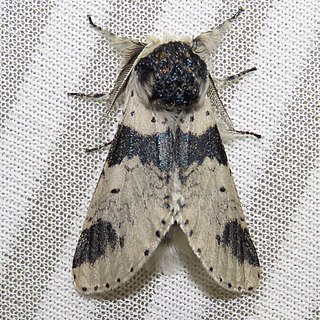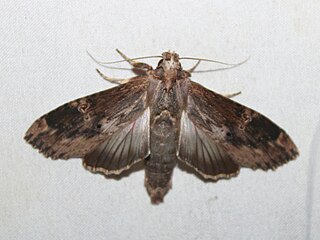
Clostera apicalis, the apical prominent or red-marked tentmaker, is a species of moth in the family Notodontidae. It was first described by Francis Walker in 1855 and it is found in North America.

Dasychira manto, the Manto tussock moth, is a species of tussock moth in the family Erebidae. It was first described by Herman Strecker in 1900 and it is found in North America.

Eurois astricta, the great brown dart, is a species of cutworm or dart moth in the family Noctuidae. It was first described by Herbert Knowles Morrison in 1874 and it is found in North America.

Heterocampa subrotata, the small heterocampa, is a species of moth in the family Notodontidae. It was first described by Leon F. Harvey in 1874 and it is found in North America.

Gonodonta pyrgo is a species of fruit-piercing moth in the family Erebidae first described by Pieter Cramer in 1777. It is found in North America.
Scotogramma fervida is a species of cutworm or dart moth in the family Noctuidae first described by William Barnes and Foster Hendrickson Benjamin in 1912. It is found in North America.

Furcula modesta, the modest furcula or modest kitten, is a species of moth in the family Notodontidae. It was first described by Hudson in 1891 and it is found in North America.

Polia richardsoni is a species of cutworm or dart moth in the family Noctuidae first described by Curtis in 1834. It is found in North America.
Euamiana dissimilis is a species of moth in the family Noctuidae. It was first described by William Barnes and James Halliday McDunnough in 1910 and it is found in North America.
Datana chiriquensis is a species of moth in the family Notodontidae. It was first described by Harrison Gray Dyar Jr. in 1895 and it is found in North America.
Lirimiris truncata is a species of moth in the family Notodontidae. It was first described by Gottlieb August Wilhelm Herrich-Schäffer in 1856 and it is found in North America.
Lacinipolia spiculosa is a species of cutworm or dart moth in the family Noctuidae. It is found in North America.

Paectes pygmaea, the pygmy paectes, is a moth in the family Euteliidae. The species was first described by Jacob Hübner in 1818. It is found in North America.

Nystalea eutalanta, commonly known as Dyar's tropical prominent moth, is a species of prominent moth in the family Notodontidae. It was first described by Harrison Gray Dyar Jr. in 1921 and it is found in North America.
Egira februalis, the mottled oak woodling, is a species of cutworm or dart moth in the family Noctuidae. It was first described by William Barnes and James Halliday McDunnough in 1918 and it is found in North America.
Chamaeclea basiochrea is a species of moth in the family Noctuidae. It was first described by William Barnes and James Halliday McDunnough in 1916 and it is found in North America.
Homorthodes mania is a species of cutworm or dart moth in the family Noctuidae. It is found in North America.
Euxoa latro is a species of cutworm or dart moth in the family Noctuidae first described by William Barnes and Foster Hendrickson Benjamin in 1927. It is found in North America.

Homorthodes hanhami is a species of cutworm or dart moth in the family Noctuidae first described by William Barnes and James Halliday McDunnough in 1911. It is found in North America.
Eurois nigra, the great black dart moth, is a species of cutworm or dart moth in the family Noctuidae. It was first described by Smith in 1927 and it is found in North America.









